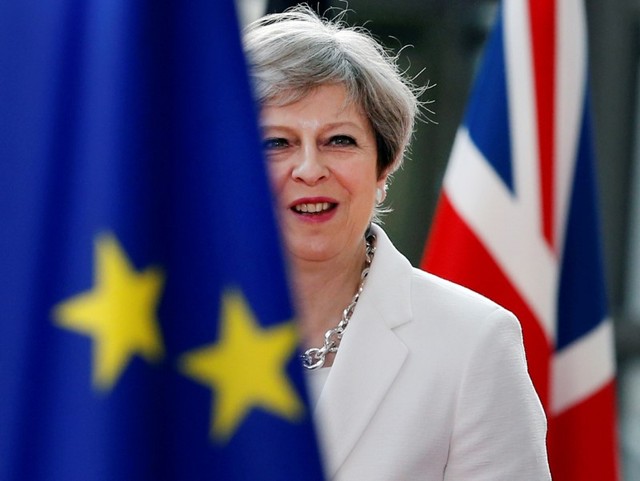LONDON (Reuters) – Prime Minister Theresa May published her blueprint for Britain’s future relations with the European Union on Thursday, proposals which would keep close trade ties after Brexit but make it harder for banks to access the European single market.
With less than nine months before Britain leaves the bloc, May has been under pressure to spell out her position to unblock the all-but-stalled talks with the EU that will shape Britain’s biggest shift in foreign and trade policies for decades.
In a long-awaited white paper policy document, her government said its negotiating position had evolved. There was one major shift – abandoning plans for close ties for financial services, Britain’s biggest export industry.
But in other areas, the 98-page document outlined the government’s plans to retain the closest possible ties with the bloc, including participating in its agencies for chemicals, aviation and medicines in a move aimed at pleasing business.
By pushing for close ties, the paper does little to ease the anger of Brexit supporters in May’s Conservative Party. Former party leader Iain Duncan Smith said: “I would like having voted to leave, to leave, not to half-leave.”
U.S. President Donald Trump, who arrived in Britain on Thursday at the start of a working visit, said before the white paper’s publication he was not sure May’s approach was what Britain voted for in the 2016 referendum.
In response, May said the proposal was “delivering on the vote of the British people to take back control of our money, our laws and our borders”.
Dominic Raab, appointed Brexit minister on Monday after his predecessor quit over the government’s approach, presented the white paper to parliament, saying: “Now, it is time for the EU to respond in kind.”
“We approach these negotiations with a spirit of pragmatism, compromise and, indeed, friendship. I hope, I trust that the EU will engage with our proposals in the same spirit,” he said to jeers from lawmakers who were not given the document.
The EU’s chief negotiator, Michel Barnier, said he would analyse the paper with member states and the European Parliament and repeated the bloc’s offer for an ambitious free trade agreement with “effective cooperation” on issues.
TIME PRESSURE
May was forced to put her cards on the table after repeated warnings from business and EU officials that she was running out of time to prevent Britain from crashing out of the bloc without a deal.
She thrashed out an agreement at her country residence on Friday only for two of her leading ministers to quit in protest at her plan to keep close trade ties.
Her team had hoped the publication of the white paper would ease concerns among many Brexit supporters but it seemed to have done little to calm a simmering Conservative rebellion.
Some Brexit campaigners will seek to harden her plan by changing her customs legislation in parliament next week.
The white paper confirms May’s desire for a “business-friendly” Brexit, trying to protect manufacturers with complex supply chains across the EU which have warned a clean break would have cost British jobs.
But the government has abandoned a plan for close ties with the EU for financial services. It will instead push to improve the EU’s current legal mechanism for access to the bloc’s financial markets known as “equivalence” – when the EU deems a country’s rules to be as robust as its own standards.
Under current equivalence rules, access is patchy and can be revoked at short notice.
The head of policy at the City of London, Catherine McGuinness, described the white paper as a “real blow”.
Many banks and insurers have, nevertheless, already scaled back their expectations of continued full access to the EU market after Brexit and started opening new hubs in continental Europe.
The white paper acknowledges there will be more barriers to the EU market post-Brexit but makes maintaining trade ties for goods a priority and details a plan for a facilitated customs arrangement with the EU.
It also says Britain wants to participate in EU agencies that authorise goods: the European Chemicals Agency, the European Aviation Safety Agency and the European Medicines Agency. Britain would accept their rules and contribute to their costs, the white paper said.
While ending freedom of movement of people, Britain will try to ensure tourists can travel freely around Europe and will try to make its immigration policy better cater for business needs.
It also proposes new bodies to help interpret rules and regulations and to resolve disputes, but Britain will still pay due regard to the European Court of Justice.
With the detail now published, May hopes to speed up the talks with the EU before Britain leaves in March next year.
“What we’ve heard so far from other leaders and from Brussels is actually a positive response that this is a proposal that we can sit down and start increasing the pace of the negotiations,” May said.






